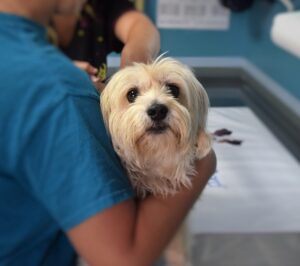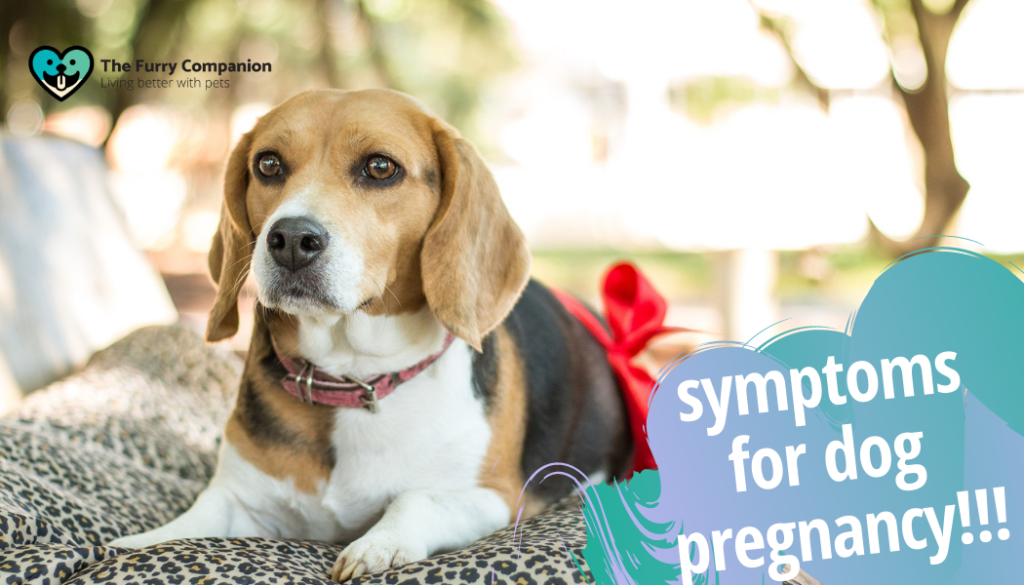A pet’s pregnancy is a beautiful and exciting event. It is a time where we get to multiply the joy and cuteness that we get from our fur babies. As wonderful as it is, it is also the most vulnerable state for female dogs, especially when they experience symptoms for dog pregnancy. And as fur parents, we want to secure their safety as they go through this journey.
Here at The Furry Companion, we share the same values with you when it comes to our wonderful fur babies. In this article, we will help you understand more about a dog’s pregnancy by knowing what are the symptoms for dog pregnancy. With this article, we also hope to guide you on properly taking care of your pet during these delicate yet precious times.
Table of Contents
What are the Symptoms for Dog Pregnancy?
Did your dog have a recent mating encounter? Do you think your dog might be pregnant? What are the symptoms for dog pregnancy you should watch out? It is relatively easy to spot the symptoms for dog pregnancy since these are very similar to humans, including fatigue, vomiting, and nausea. However, since dogs cannot communicate the way humans do, your furry friend’s pregnancy may be more challenging to handle.

Typically, a dog’s pregnancy can take up to 63 days or nine weeks on the average. One of the first things you should know is that most dogs would not show signs in the first several weeks. Symptoms for dog pregnancy usually appear only about three weeks into pregnancy. According to veterinarians, towards the second trimester, you will start noticing the following symptoms for dog pregnancy:
Morning Sickness or Vomiting
Just like humans, some pregnant dogs can also have their kind of morning sickness. Vomiting in dogs is when they forcefully expel either fluids or food from their stomach and upper small intestine. Vomiting, as a symptom for dog pregnancy, is usually accompanied by nausea, drooling, and contractions of the abdomen.
Morning sickness is your dog’s bodily reaction to the hormonal changes that come with pregnancy. However, this is quite an uncommon case. If your dog experiences them, the vomiting can last around 21 to 25 days and occurs in short-lived episodes. Fortunately, this episode usually resolves on its own within a week.
But still, the vomiting can also impact your dog’s behavior and appetite, as well as it may lead to dehydration. Make sure to consult a veterinarian to handle your dog’s pregnancy properly. Give your dog these pills to alleviate its morning sickness.

Changes in Appetite
There are two courses where your pet’s appetite can go. Your dog’s appetite can either decrease or increase during this period. If your dog is going through morning sickness and vomiting, it can weaken your dog’s appetite. Meanwhile, your dog’s appetite has a possibility of increasing since she also needs more nutrition for the extra cuties she is now carrying.
If you notice a loss in appetite for your dog, pay close attention to her as it can be fatal, especially if indeed she is having her pregnancy. After a week of vomiting, Dr. Jessica Romine, DVM, a specialist in small animal internal medicine, reminded us to be cautious. “If she will not eat at all, or if the signs persist longer than this, she should be seen by your veterinarian to be sure nothing more serious is happening,” she says.
Meanwhile, another possible route is an increase in appetite. However, the increase in calorie intake may only occur if your dog is already halfway through the pregnancy. Before the halfway mark or in the first 30 days of pregnancy, avoid encouraging an increase in food intake since it may negatively affect the overall pregnancy. Instead, it would be best if you continue giving her the usual and well-balanced diet. Give them this dog food.
Bodily Changes
Similar to humans, one of the symptoms for dog pregnancy is significant bodily changes. It may be with your dog’s weight, size of certain parts of the body, and even bodily discharge.
Weight Gain
It is only normal that weight gain would come with pregnancy, but of course, it should still be within a fair amount. Doctor Romine explains, “Weight gain is not seen until about seven weeks, and from there until birth, her weight may increase up to 50 percent above her normal weight.”
You may start noticing some weight gain as early as 21 days into the pregnancy and becomes more noticeable after the 35th day. As the pregnancy progresses, your dog will likely gain 15% to 25% of the weight.
Enlarged Abdomen
An increase in the size of the abdomen is one of the most typical symptoms for dog pregnancy. However, this may only be visible towards the mid-pregnancy stage as the growing pups will need more space.
Enlarged Nipples
As your mommy doggy prepares for motherhood, you may also notice her nipples beginning to enlarge and may turn pinker. The color change comes around 25-39 days into the pregnancy and is mainly due to a surge in blood supply around the area.
By 40 days of pregnancy, you may also notice a small amount of clear liquid coming out from her breasts, which is perfectly normal. Around this time, the mammary glands begin to enlarge in preparation for milk production.
Body discharge
Within the first 30 days of pregnancy, your dog may have a clear or mucoid discharge from her vulva. This type of discharge is normal. However, if you observe that it comes with a foul odor or becomes brownish, it is a sign that there’s something wrong.
Meanwhile, a dark green discharge from the vagina can mean that your dog mommy is ready to go into labor. If, after a few hours, your dog does not go into labor, contact your vet immediately.
Fatigue
The changes your soon-to-be-mommy doggy is undergoing through can take a toll on their energy. Fatigue is common among pregnant dogs, especially in the first few weeks. Around this time, the symptoms usually come with nausea and vomiting.
Concerning fatigue, your dog’s sleeping patterns may also change. You may observe her sleeping or resting more than usual, especially in the early and final stages of pregnancy.

Behavior Changes
As your dog’s body goes through significant hormonal changes, their behavior is most likely affected by the change. Behavioral changes, as one of the symptoms for dog pregnancy, can differ for each dog; it can mean any deviances from your dog’s typical behavior.
In some cases, if your dog is pregnant, you will likely notice that she becomes overly clingy and affectionate. You will find her often by your side, and may even get upset when you leave them.
Meanwhile, some dogs can be on the extreme side. Symptoms for dog pregnancy can make a dog ill-tempered and avoidant of any close contact than they usually are. Give your dog this toy to help it relax.
How to Confirm Your Dog’s Pregnancy?
Now that you are familiar with the common symptoms for dog pregnancy, how do you confirm it? There are a couple of ways to do this:
Veterinary Confirmation
These methods are aided by a professional veterinarian and require consultation. You should have the visit three weeks after the first suspected symptoms for dog preganncy because it is only by that time when they will be more visible. But you should seek emergency help if you experienced unusual conditions, such as rare discharge or when your dog has not been eating.

Palpation
An experienced veterinarian can correctly do this traditional method of detecting pregnancy. Palpation is a method wherein the vet carefully examines the abdomen’s surface by pressing on it lightly. It aims to detect any swelling in the uterus that may indicate pregnancy.
However, this is an unreliable method for pregnancy detection, and you should not rely on this alone. Apart from it only being useful after three weeks of pregnancy, any detected swelling may not necessarily mean pregnancy; it could just be a sign of another body problem.
Abdominal X-Rays
Abdominal x-rays can confirm the number of puppies your doggy will deliver. Vets can conduct in the last week of pregnancy wherein the bones of the puppies are more visible on an X-ray image.
Ultrasound
The most reliable test in detecting dog pregnancy is through abdominal ultrasound. As early as three weeks, ultrasound can detect embryos as well as viable features.
Blood Test
Another method to detect pregnancy is by a blood test after the reproductive cycle has ended. The hormone called relaxin can also indicate pregnancy. Relaxin is released due to the presence of embryos in the uterus.

Taking Care of Your Pregnant Dog
If the tests mentioned above came back positive, congratulations, you are now a fur grandparent! Once you confirmed your dog’s pregnancy, it’s essential to take proper good care of her.
Here are some tips for taking care and managing symptoms for dog pregnancy from Dr. Carol Margolis. Dr. Carol Margolis, DVM, is a lecturer in pediatrics, genetics, and reproduction for the School of Veterinary Medicine at the University of Pennsylvania.
Nutrition and Exercise
More than ever, proper nutrition and exercise are critical in pregnancy. Otherwise, complications in pregnancy and whelping, the actual birth of dogs. Some of these problems may include obesity; “obesity can lead to issues during natural whelping, increase neonatal mortality and lowers fertility in general,” Dr. Margolis, DVM says.
Doctors do not recommend strenuous exercise for pregnant dogs. Instead, we usually let them set her own pace by helping them do her usual activities. Johnny D. Hoskins, DVM, PhD, DACVIM says, “Performance bitches should stop heavy work activities during pregnancy; herding, agility, field and advanced obedience work are discouraged due to the risk of abdominal trauma and the potential stress to the fetuses.”
When it comes to eating habits, if you will remember, there is a tendency for our dogs to increase appetite and weight. However, we should take it slow on encouraging them to eat. Vets recommend to gradually increase the food for about 25% per week towards the last four weeks of the pregnancy.
Discuss your dog’s diet plan with your veterinarian to avoid mistakes. Note that giving extra calcium more than the appropriate lactation diet may suppress her natural calcium production, leading to low calcium overall.
For the best dog food of 2020, you can check this article for more information.
Prepare Your Dog For Her Labor
The primary importance of understanding the symptoms for dog pregnancy is to prepare for her birth better.
After confirming the tests, it’s best to create a private area with a box where your dog can safely give birth. Keep the box and the area clean and free from infectious diseases and bacteria. Also, prepare in case you need to rush your dog to the emergency. Ensure that if something goes wrong, you can rush to the nearest pet hospital right away.
Final Thoughts
Having another fur baby is indeed a blessing we are all excited for. As much as we can, we want to do everything to secure their safety and well-being. Educate and prepare yourself as early as now about the symptoms for dog pregnancy and how to handle them. Soon, you will have more fur buddies with cuteness overload by your side.

Frequently Asked Questions
How can I tell if my dog is pregnant or having a false pregnancy?
A false pregnancy mimics the symptoms for dog pregnancy. If you are sure that your dog has not mated, then these symptoms are just pseudopregnancy. If the symptoms do not go away after three weeks, consult the vet right away. To confirm if there is pregnancy or not, your veterinarian may run the following tests:
- Ultrasound
- X-rays
- Hormone testing
- Palpation
What are nesting behaviors in dogs?
Nesting behavior may be one of the most evident symptoms for dog pregnancy or pseudopregnancy. When you catch your dog burrowing into blankets or scratching out some dirt to sleep in cold weather or at night. Cuddling into sheets of blankets and other nesting-like behaviors are normal because dogs find it comfortable.
However, it can be alarming if the behavior becomes more critical that may indicate real or false pregnancy:
- Shedding blankets
- Digging into small spaces
- Over-grooming

Will my dog get pregnant the first time she mates?
The typical reproductive age of dogs begins around the time they turn one year old. As soon as your dog starts with the estrous cycle, your dog can get pregnant when she mates.
However, veterinarians do not recommend getting a dog pregnant in the first cycle to avoid stress and complications with young pregnancy.
How many puppies does a dog have in their first litter?
A dog on her first pregnancy produces fewer than usual—the first litter averages from around two to three litters only.
How many times do dogs mate to get pregnant?
Generally, for mating to be successful, it takes around two to three times of mating with a 24 to 48-hour interval. The ideal time of mating is on the 10th or 14th day of the female’s estrus.

How many puppies do dogs have?
According to a study, the average litter size of average-sized breeds is around five puppies. Smaller breed types produce around three puppies, while larger breed types can produce more,
of about seven puppies.
How much does it cost to see if your dog is pregnant?
The cost of confirming symptoms for dog pregnancy depends on the type of service you will choose and where you will get them. Here are some of the example prices of the tests and procedures:
- Over-the-counter dog pregnancy test: $20 to $30 or more
- X-rays, ultrasound, and bloodwork: From $25 to $65 and $200-$300
Can a 14-year-old dog get pregnant?
There is no menopause for dogs, and there is still a chance for 14-year-old dogs even to get pregnant. However, the success of fertility decreases as your dog grows older. Not only that, the risk for pregnancy also increases because her body may no longer be in good condition to bear puppies.
Is it okay to walk a pregnant dog?
Definitely! Despite being pregnant, your dog still needs the exercise. However, you have to make sure that they don’t over-exert themselves. Also, 30 days into the pregnancy, you should make your walks shorter so that your pregnant dog does not get overtired from the exercise.
What are the stages of dog pregnancy?

